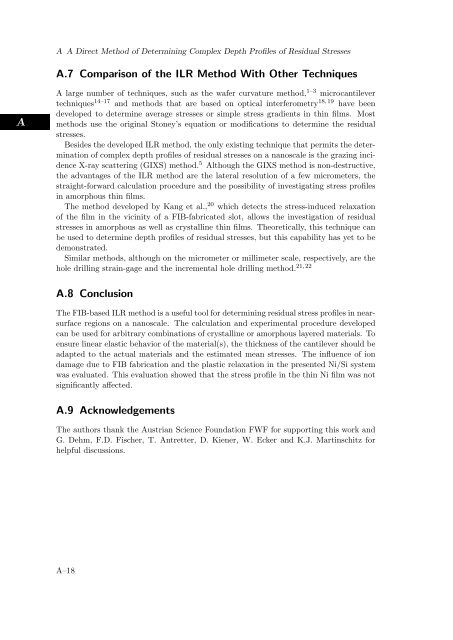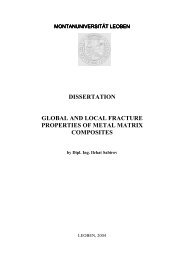1 - Erich Schmid Institute
1 - Erich Schmid Institute
1 - Erich Schmid Institute
Create successful ePaper yourself
Turn your PDF publications into a flip-book with our unique Google optimized e-Paper software.
A<br />
A A Direct Method of Determining Complex Depth Profiles of Residual Stresses<br />
A.7 Comparison of the ILR Method With Other Techniques<br />
A large number of techniques, such as the wafer curvature method, 1–3 microcantilever<br />
techniques14–17 and methods that are based on optical interferometry18, 19 have been<br />
developed to determine average stresses or simple stress gradients in thin films. Most<br />
methods use the original Stoney’s equation or modifications to determine the residual<br />
stresses.<br />
Besides the developed ILR method, the only existing technique that permits the determination<br />
of complex depth profiles of residual stresses on a nanoscale is the grazing incidence<br />
X-ray scattering (GIXS) method. 5 Although the GIXS method is non-destructive,<br />
the advantages of the ILR method are the lateral resolution of a few micrometers, the<br />
straight-forward calculation procedure and the possibility of investigating stress profiles<br />
in amorphous thin films.<br />
The method developed by Kang et al., 20 which detects the stress-induced relaxation<br />
of the film in the vicinity of a FIB-fabricated slot, allows the investigation of residual<br />
stresses in amorphous as well as crystalline thin films. Theoretically, this technique can<br />
be used to determine depth profiles of residual stresses, but this capability has yet to be<br />
demonstrated.<br />
Similar methods, although on the micrometer or millimeter scale, respectively, are the<br />
hole drilling strain-gage and the incremental hole drilling method. 21, 22<br />
A.8 Conclusion<br />
The FIB-based ILR method is a useful tool for determining residual stress profiles in nearsurface<br />
regions on a nanoscale. The calculation and experimental procedure developed<br />
can be used for arbitrary combinations of crystalline or amorphous layered materials. To<br />
ensure linear elastic behavior of the material(s), the thickness of the cantilever should be<br />
adapted to the actual materials and the estimated mean stresses. The influence of ion<br />
damage due to FIB fabrication and the plastic relaxation in the presented Ni/Si system<br />
was evaluated. This evaluation showed that the stress profile in the thin Ni film was not<br />
significantly affected.<br />
A.9 Acknowledgements<br />
The authors thank the Austrian Science Foundation FWF for supporting this work and<br />
G. Dehm, F.D. Fischer, T. Antretter, D. Kiener, W. Ecker and K.J. Martinschitz for<br />
helpful discussions.<br />
A–18
















